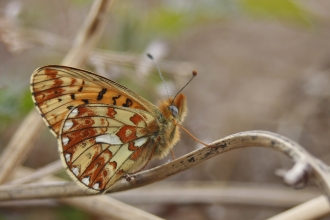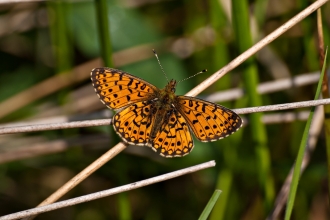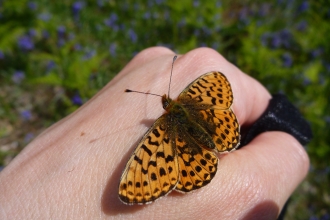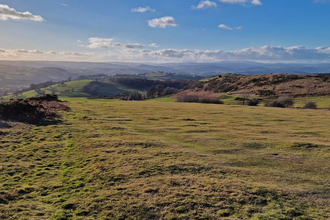
Pearl-bordered Fritillary butterfly in close up © MWT/Tammy Stretton
Precious Pearls
Montgomeryshire's Precious Pearls (https://youtu.be/ht5qqXEBhUk)
This short film, produced for Montgomeryshire Wildlife Trust by Greengage Films and voiced over by Iolo Williams, explains how we are helping save the Pearl-bordered Fritillary butterfly for future generations to enjoy.
The Pearl-bordered Fritillary butterfly has undergone a dramatic decline in status and range within Wales in recent decades. It is now restricted to a handful of sites within Wales and the last remaining stronghold is Montgomeryshire, where populations are now known to occur on six sites.
What is the PBF & why is it rare?
The Pearl-bordered Fritillary (PBF), Boloria euphrosyne, is the earliest of the small fritillary butterflies to appear in the spring often flying in the first week in May. Emergence may occur in mid April in very early seasons, or be delayed until the middle of May in late seasons. The Pearl-bordered Fritillary is difficult to distinguish from its close relative the Small Pearl-bordered Fritillary (Boloria selene), which rarely flies before the third week of May. The caterpillars of both species feed on violets, most often Common Dog-violet.
The PBF was originally a widespread butterfly, rapidly lost with the cessation of woodland management. South facing bracken-covered hillsides are now the main remaining habitat in Wales, but these are vulnerable both to overgrazing by sheep or the abandonment of grazing.
Pearl-bordered Fritillary butterfly pair © MWT/Tammy Stretton
Monitoring the PBF
Montgomeryshire Wildlife Trust has been working to conserve the Pearl-bordered Fritillary in this part of Wales for over 20 years. In 2002, a standard methodology was agreed with the Countryside Council for Wales (CCW) and Butterfly Conservation, to undertake monitoring in a specific way, allowing data to be compared across sites and years. Data is collected on the number of adult PBFs, as well as the presence or absence of certain habitat indicators.
The graph below shows the total adult PBF numbers on all Montgomeryshire sites since 2002.

Total Pearl-bordered Fritillary butterflies (PBF) in Montgomeryshire 2002 to 2025
Action for PBF
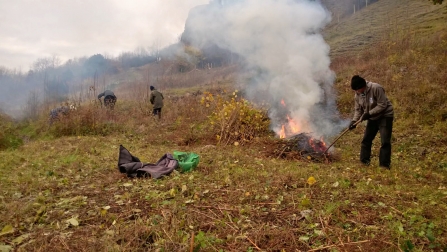
Volunteers undertaking habitat management for the Pearl-bordered Fritillary butterfly at Llanymynech Rocks Nature Reserve © MWT
The main threat to the PBF in this part of the world is lack of sufficient and type of grazing. Without this, the habitat can be quickly smoothered by dense scrub and bracken, shading out all else. The butterflies need some bracken and scrub to maintain a warm micro-climate, as well as providing litter for egg-laying, but they also need access to flowering plants for nectar and violets for their caterpillars.
Working with landowners and graziers, we have undertaken a large amount of scrub & bracken clearance, aiming to cut different areas in different years, to promote the conditions which the PBF needs. It is this work which has changed the fortune of this rare butterfly, in this part of the world and without it, we would soon lose the species entirely. To really safeguard the future of the Pearl-bordered Fritillary, the challenge remains on how to get the grazing right and it is this that the Trust has been and will continue to work towards.
Everything coming up roses?
Where consistent management has been undertaken, the PBFs have generally responded positively. However, this is only half the picture. PBFs can also be severely impacted by weather. Calm, warm, sunny days can be very hit and miss in Spring, affecting the ability of the butterflies to breed. Cold, wet weather over the summer months may also negatively impact on the caterpillar’s survival, although their choice of habitat could mitigate this to some degree. As the graph shows, recent years have been challenging and sadly, we have lost three colonies in the area.
With the vagaries of our changing climate, and other pressures besides, it is now more important than ever for us to continue regular management and seek opportunities to expand the population. As long as we can get the support we need, we will continue to fight the PBFs corner. We truly hope that the next 20 years are kinder for this special little butterfly.
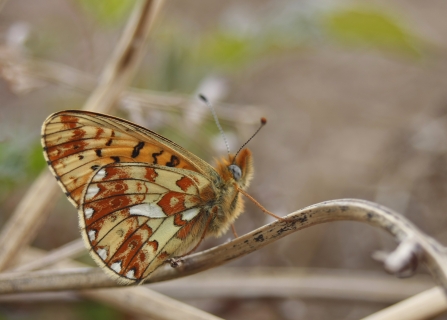
Pearl-bordered Fritillary butterfly © Tamasine Stretton

